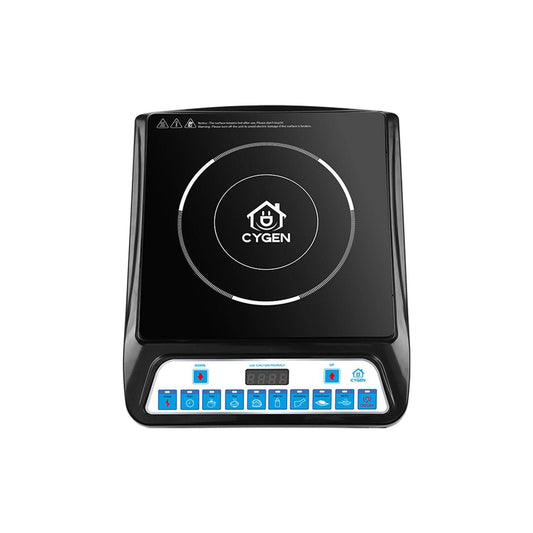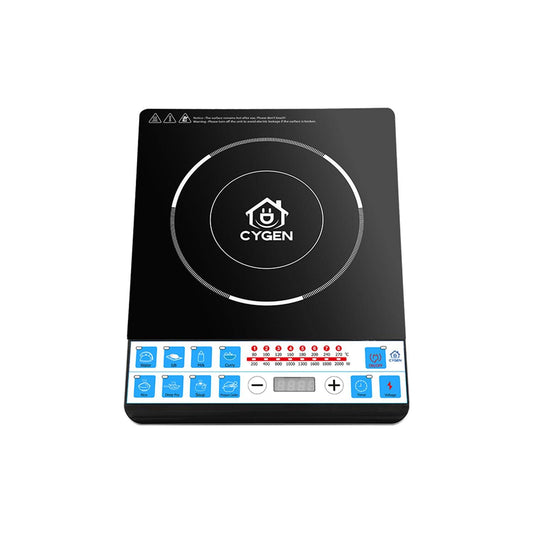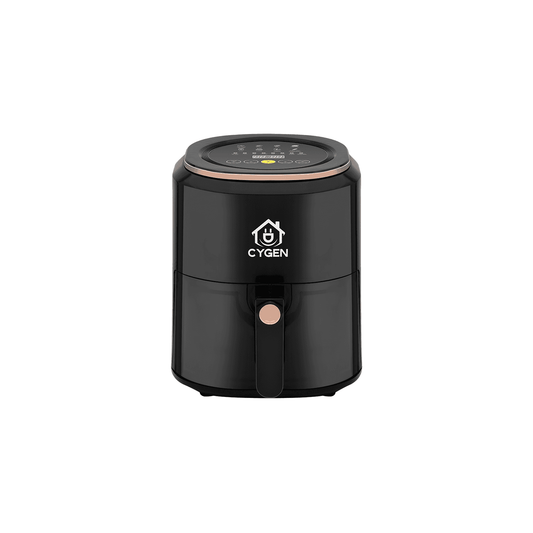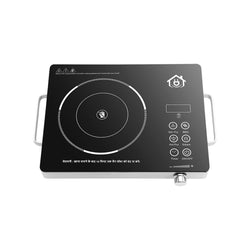 So, you’ve heard about induction cooktops and now you’re wondering how to use an induction cooktop the right way. Maybe you just bought one, or maybe you're planning to switch from gas or electric stoves. Either way — you're in the right place!
So, you’ve heard about induction cooktops and now you’re wondering how to use an induction cooktop the right way. Maybe you just bought one, or maybe you're planning to switch from gas or electric stoves. Either way — you're in the right place!
Induction cooking is growing fast. More people are choosing it for their kitchens because it’s faster, safer, and super energy-efficient. It’s also a cleaner and more modern way to cook, with no open flame or heating coil.
But here’s the thing — if you’re new to induction, it can feel a bit confusing at first. Don’t worry! This induction cooktop beginner guide is here to make things super simple for you.
We’ll walk you through everything:
-
What makes induction different
-
Why it matters to use it the right way
-
Smart and easy induction stove tips for your daily cooking
Let’s start by understanding what makes this shiny new induction stove different from the one you’ve used before!
 What Is An Induction Cooktop & How It Works
What Is An Induction Cooktop & How It Works
Thinking about switching to an induction cooktop? Or maybe you're just curious how this smooth, glass-top burner heats your food so fast without a visible flame? Don’t worry—we’ll break it all down for you in the simplest way possible.
What Is An Induction Cooktop?
An induction cooktop is a modern way to cook your food. It looks sleek, works fast, and keeps your kitchen cooler and safer. But here’s the cool part—it doesn’t use fire or a hot coil like gas or electric stoves.
Instead, it uses magnetic energy to directly heat your pots and pans. So, your cookware gets hot, but the surface around it stays cool. Sounds like magic? Let’s explain.
Here’s a short and sweet version of how induction cooking works:
-
Underneath the smooth glass surface is a coil of wire.
-
When you turn it on, electricity flows through that coil and creates a magnetic field.
-
If you place a magnetic pot (like cast iron or stainless steel) on top, that magnetic field creates heat inside the pan.
-
The pan gets hot and cooks your food—but the cooktop itself stays cool to the touch!
So basically, the pan becomes the heater, not the cooktop. That’s the secret.
Induction Burner vs Gas vs Electric: What’s The Difference?
Let’s make it super easy to compare and decide!
|
Feature |
Induction Cooktop |
Gas Stove |
Electric Stove |
|
Heat Source |
Magnetic field (induction) |
Open flame |
Electric coil or plate |
|
Speed |
Very fast |
Medium |
Slow |
|
Control |
Instant, precise |
Good control |
Less precise |
|
Safety |
Cooktop stays cool |
Open flames, fire risk |
Hot coils can burn |
|
Cleaning |
Flat, easy to clean |
Burner grates, messy |
Coil plates, harder to clean |
So, induction wins in speed, safety, and ease of use. It’s like cooking in the future.
Why People Love Induction Cooking ( + Cons)
Cooking can be fun, but waiting for pots to heat up or dealing with messy burners? Not so much. That’s where induction cooktops come in. They’re fast, safe, and super easy to use, making them a favorite in modern kitchens.
Here’s why more and more people are switching to induction cooktops:
Super Fast Cooking
Induction cooktops heat up much faster than gas or electric stoves. You can boil water in under 2 minutes. No more waiting around!
Cooler Kitchen
Only the pot gets hot, not the cooktop or the air around it. That means your kitchen stays cooler—especially helpful in summer.
Very Safe
No flames. No red-hot coils. If there’s no pan on the cooktop, it won’t heat up at all. Great if you’ve got kids or pets at home.
Saves Energy
Induction is energy efficient. It uses less electricity because it heats only the cookware, not the whole burner area.
Easy To Clean
Spills don’t burn onto the surface because the glass top doesn’t get very hot. Just wipe it down. Done!
But as we know, every advantage has a disadvantage. To be honest, here are a few:
-
You’ll need magnetic cookware. ( A quick tip: If the magnet sticks to the bottom of your pot, it’ll work on induction.)
-
Induction cooktops can be a bit pricey compared to gas or electric models.
-
You’ll need electricity, so in a power cut, you can’t cook.
So, what is an induction cooktop? It’s a faster, cleaner, and safer way to cook using magnetic energy. If you want better control, less mess, and modern design in your kitchen, induction might be your best friend.
Compared to gas or electric, it’s smart cooking without the hassle. Ready to make the switch?
 The Right Cookware For Induction
The Right Cookware For Induction
Switching to an induction stove? You’re in for a treat—fast cooking, energy-saving, and no open flame. But there’s one thing you must get right: your cookware.
Not all pots and pans work on an induction stove. Let’s break it down so it’s super easy to understand. Whether you’re new to induction or just shopping for the right tools, this guide is all you need.
Why do you need special cookware for induction stoves?
Induction stoves don’t work like gas or electric ones. They heat the pan directly using magnetic energy. So, if your cookware isn’t magnetic, it simply won’t heat up. Yes—your stove will stay cold, and your food won’t cook!
And, what makes a pan work on induction?
It’s all about the magnetic base. If the bottom of your pan can attract a magnet, it’s likely good for induction. The base needs to contain iron or steel—something magnetic.
What Works: Cast iron, stainless steel (but not all types) and some enameled steel pans.
What Doesn’t Work: Aluminum, copper, glass, ceramic (unless it has a magnetic base).
But still, we can’t do the guesswork every time you purchase cookware. Here’s how to test if your pan works—It’s called “The Magnet Test”:
-
Take a fridge magnet.
-
Stick it to the bottom of your pan.
-
If it sticks firmly, your pan is induction-ready.
-
If it slides off or doesn’t stick, it won’t work.
Easy—that’s it! No tech. No fancy tools. Just a simple magnet.
What If You Love A Non-Induction Pan?
Don't worry—there’s a fix.
You can buy an induction converter plate. Place it on the stove, and your non-magnetic pan goes on top. It acts as a bridge. But it’s not as efficient. Heat takes longer, and you lose the main benefits of induction.
Best Types Of Cookware For Induction
There are so many kinds of cookware in use that one might get confused about what to buy or not. Let us make that easy for you. Let’s look at the types of pans that do work and work well.
1. Cast Iron
Heavy and super magnetic. Heats evenly and holds heat well.
Great for: Stews, curries, and slow cooking.
2. Stainless Steel (Magnetic)
Durable, sleek, and easy to clean. But make sure it’s magnetic stainless steel, or it won’t work.
Great for: Everyday cooking, boiling, sautéing.
3. Enameled Cast Iron
All the goodness of cast iron, but with a smooth, colorful coating.
Great for: Soups, sauces, and one-pot meals.
4. Clad Cookware
These have multiple layers—usually aluminum sandwiched between magnetic stainless steel.
Great for: Even heating, fast response to temperature changes.
Getting the right cookware for induction isn’t hard—you just need pans with a magnetic base. Use the magnet test and pick induction-friendly materials like cast iron or stainless steel.
And remember, cooking on induction is fast and efficient, only if your cookware is right.
Ready to cook smarter, faster, and safer? Check your kitchen for induction-ready pots—or treat yourself to a new set that fits your stove and style!
 5 Steps: How To Use An Induction Cooktop
5 Steps: How To Use An Induction Cooktop
So, you’ve got your hands on a shiny new induction cooktop? Great choice! It's fast, safe, and super easy once you know how it works. If it’s your first time using an induction stove, don’t worry—we’ve got you covered. Let’s break it down step by step in the simplest way possible.
1. Plug In & Position The Cooktop
Before anything, plug in your induction cooktop.
-
Make sure it’s on a flat, dry surface
-
Keep it away from walls or other appliances
-
Leave some space around it so heat can escape easily.
Once it’s in the right spot, you’re ready for the next step.
2. Place The Right Cookware On It
Not all pots and pans work on induction. You need cookware that has a magnetic base. Now, place the pot or pan right in the center of the cooking zone. The cooktop won't turn on unless it detects the right pan.
3. Touch The Controls To Power It On
Look for the power button on your induction hob. It’s usually marked with a circle and a line.
-
Tap the power button to turn it on.
-
You’ll see the display light up.
Some cooktops have a slight beep sound when you press the buttons; that’s normal!
4. Choose A Heat Level Or Power Setting
Once it’s on, you’ll need to pick a heat level.
-
You’ll see a ‘+’ and ‘–’ sign or numbers on the panel.
-
Tap to increase or decrease the heat.
Start on a low setting if you're new. You’ll see how fast it heats up. There’s no flame, but the cookware gets hot quickly, so stay alert!
You can also use cooking modes ( if your cooktop has it). You can tap the mode—boil, fry, keep warm, milk—that suits your cooking. The cooktop will adjust heat automatically.
Many models also offer a timer feature: just tap the timer on, use the ‘+’ or ‘-’ to set your time.
Once the timer ends, the cooktop turns off by itself. It’s great if you’re multitasking or tend to forget things on the stove. It’s super handy for beginners!
5. Cooking Done? Turn It Off!
When you’re finished cooking,
-
Tap the power button again to turn it off.
-
Remove the cookware carefully—it may be hot!
-
Wipe the surface once it cools.
Induction cooktops don’t stay hot for long, but always be careful.
If you’re using an induction stove for the first time, remember: Use flat-bottomed cookware for best contact. Don’t slide pans; lift them up. Clean and unplug after use.
Using an induction cooktop is simple once you try it. It heats fast, cooks evenly, and makes life easier. Just follow these basic induction hob instructions, and you’ll be cooking like a pro in no time.
So go ahead—plug it in, place your pan, and press start. Let the magic begin!
 5 Essential Induction Stove Tips For Beginners
5 Essential Induction Stove Tips For Beginners
Induction stoves are smart, fast, and super energy-efficient. But if you're new to using one, it can feel a bit tricky at first. Don’t worry—we’ve got your back.
Here are five simple and helpful induction stove tips that’ll make your cooking smoother, safer, and more fun.
1. Don’t Heat Empty Pans
This is a big one. Never put an empty pan on an induction stove and turn it on.
Why? Because induction stoves heat up really fast, and if there’s nothing inside the pan, it can get too hot and get damaged.
Quick tip: Always add oil, water, or food before turning on the heat.
2. Clean After Each Use
Induction cooktops look sleek—and they should stay that way! Spills, oil splashes, or crumbs can stick to the surface if not wiped right away.
Make it a habit:
-
Let the surface cool
-
Wipe it with a soft cloth or sponge
-
Avoid harsh cleaners or steel scrubbers
A quick clean after every use keeps your cooktop shiny and working well.
3. Keep Your Cookware Centered
For the best results, place your pots and pans right in the middle of the cooking zone. Induction stoves only heat the area under the pan. If your pan isn’t centered, it might not heat evenly.
Why it matters: Because the food cooks better, heat is spread more evenly, and most importantly, it’s more energy efficient.
4. Say No To Aluminium Foil And Plastic
This one's important for safety. Don’t put aluminum foil or plastic near or on the cooktop. Aluminum foil can heat up and even melt. Plastic can melt too and stick to the glass surface, which is tough to clean and can damage your stove.
Instead, use proper lids, pots, and pans that are made for induction cooking.
5. Use Induction-Friendly Cookware
Not all pots and pans work on induction cooktops. You need ones with a flat, magnetic bottom.
Take a fridge magnet and stick it to the bottom of your pan. If it sticks well—yay! It works. If not, it won’t heat up on an induction stove.
Induction stoves are super smart and safe when you know how to use them. Just remember to treat them right—don’t overheat, clean regularly, and use the right cookware. With these five easy tips, you’ll feel more confident in the kitchen and enjoy the perks of cooking with an induction stove.
 Mastering Induction Cooking
Mastering Induction Cooking
Learning how to use an induction cooktop isn’t hard — it’s just different.
Once you understand the basics, it becomes second nature. With the right cookware, a little patience, and the tips we shared, you’ll be cooking like a pro in no time.
Remember, start simple. Keep the heat low at first, and always make sure your pan is on the burner before turning it on. Cleanup is quick, cooking is faster, and the whole process feels smoother.
With the right cookware and a few simple tips, anyone can enjoy faster, cleaner, and more efficient cooking. From boiling water in seconds to evenly cooked meals with no mess, induction cooking truly transforms the kitchen experience.
For beginners, the key is to start small. Use compatible pots and pans, begin with low to medium heat, and always place cookware on the burner before turning it on. With just a little practice, the process becomes quick and effortless.
If you've never tried cooking on induction before, now is the perfect time. Say goodbye to long preheating, burnt spills, and stubborn stains. Discover how easy and enjoyable cooking can be with a technology that works smart, not hard.
Ready to make the switch? Explore our latest induction cooktop and start cooking the modern way — faster, safer, and smarter.
 FAQs
FAQs
1. What kind of cookware works with an induction cooktop?
Only magnetic-based cookware such as cast iron, stainless steel (with a magnetic base), or cookware marked as "induction compatible" will work. You can test your existing pots with a magnet—if it sticks to the bottom, it’s induction-ready.
2. Is it safe to touch the induction cooktop surface after cooking?
Yes, it’s generally safe. The induction cooktop itself doesn’t heat up—only the pan does. However, there might be residual heat from the cookware, so always be cautious and check for heat before touching.
3. How do I clean my induction cooktop?
Let the cooktop cool down, then wipe the surface with a soft cloth or sponge and a mild cleaner. Avoid abrasive scrubbers or harsh chemicals that could damage the glass surface.
4. Why won’t my induction cooktop turn on or heat the pan?
Common reasons include using incompatible cookware, improper pan placement, or the cooktop’s safety lock being activated. Make sure the pan is centered and flat-bottomed and that the cooktop is plugged in correctly.









Leave a Reply
Nunc vehicula quam semper odio varius tincidunt. Vestibulum ante ipsum primis in faucibus orci luctus et ultrices posue.
Please note, comments need to be approved before they are published.